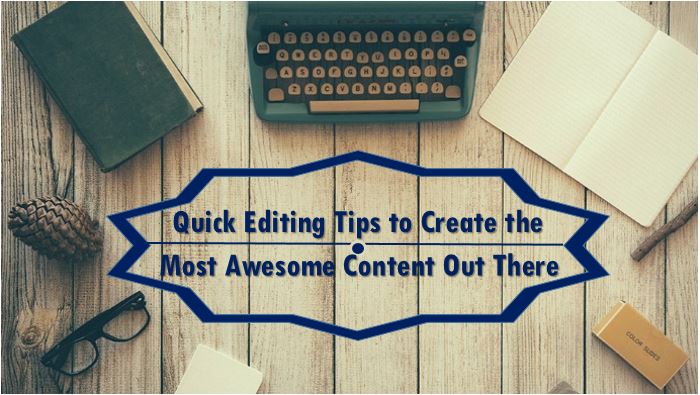Whether you are a best-selling novelist or a small online blogger, you have got to edit your work. Your first draft is always garbage of your thoughts disorganized and points that are uncertainly stated. Ever since writing dawned, it started with chaos and was restructured to end in order. Quick editing tips are such an important part of writing that you should be dedicating a big chunk of your writing time. While you go through your first draft, you need to check if your content is the best you have to offer and whether it’s got a flow or a rhythm going on in it.
Every writer creates a piece of content with a goal. For most of us, saving time while also polishing our writings is the main goal. Here are ten editing tips just to help you achieve this goal of presenting your best work in no time.
Write Awesome with these 10 Quick Editing Tips
So you have just finished writing your first draft and now it’s time to edit before you hit that “publish” button. But before you edit, I suggest you run away and leave off that piece you have been writing. If you were to do it all in just one sitting, you are committing the big blunder of letting all the errors fool your eyes into believing they don’t exist. Talk about ghosts in your content! When it’s time, wear those horn-rimmed eyeglasses and use these quick editing tips to make sure that you have hit the right notes and end up with the perfect final piece of content.
Tip #1 Skim the cream off your content
People read quickly these days and skim your content as much as possible without going over each and every word. So why not make it easy for your audience by keeping your content crisp, brief and fat-free? For your readers’ sake, don’t add so much fat into content by dragging out your sentences. Break up your content into bullet points with interesting benefit-driven sub-headers.
Take a look at these sentences and see the difference when reading them without the bolded words.
- Every single person should read.
- But the real issue here is people have a short attention span.
- You are going to have to keep your writing short and brief.
Don’t you feel that these sentences are better off with the bolded words?
Tip #2 Use commas only wherever needed
In the English language, there are lots of rules to be followed when using punctuation. Even the usage of the little comma is subject to so many rules and regulations. Don’t over-complicate commas by putting them here and there like mayo on your sandwiches! The idea is to read your sentences out loud and if you feel that a certain sentence is longer than ordinary, break it up with a comma. Alternately, use commas on those spots you feel that the reader is going to stop reading.
Tip #3 Remove Empty Filler Words
The use of phrases like “here is”, “it takes” and “there is” takes the focus from the nouns in a sentence. They require other filler words to combine with them like who, how, and when. Such phrases also stretch your sentences longer than necessary.
If your sentences contain a lot of these phrases, then it’s time to rewrite them.
Here are some examples so you can teach yourself to rectify them:
- It’s fun to read- Reading is fun
- There are many people who love to read- Many people read
- Here are some DIY ideas for you to try- Some DIY ideas for you to try are
If you have already given a little description of the subject, then it’s okay to use words like “here”, “it” and “there”. For instance: I love being an SEO Analyst. It’s a great profession.
Tip #4 Replace weak verbs with strong ones
Certain words can reduce the impact of what we are implying. Look out for those words and replace them with strong, powerful verbs. It can drive home the point you are stating through your content, besides making it interesting.
Certain examples:
- She had gone from Greece to Rome- She traveled from Greece to Rome
- Dominos is giving out coupons- Dominos offers coupons
- Make out a plan- Create a plan
Tip #5 Use Powerful Adjectives
Avoid using so much of “real” and “very” when you are describing something. Many people use “very good”, “really bad” to emphasize something while speaking. It looks good when you speak but when you write it down on paper, you get to see the difference. Words like “very” and “really” sound inadequate and are so much less of an intensifier than they ought to be. Keep in mind your reader’s time is precious. It pays not to waste his time by being as concise as possible. Get straight to the point with confidence using power words.
- Really bad- Dreadful
- Really good- Exceptional, Marvelous
- Very Huge- Enormous, Tremendous
- Very impressive- Catchy
Example: 5 Marvelous Benefits of Data Entry Service Outsourcing
When you use power words, remember to deliver your readers something that’s in pace with those adjectives. Don’t charge up your audience’s expectations and then give them some mediocre content to read. I gotta tell you, it’s a crime!
Tip #6 Use contractions
Contractions make your writing sound more friendly, conversational, and informal. You don’t want your reader thinking that he’s reading a newspaper or a textbook. Examples of contractions are it’s, I’m, you’re, gonna, wasn’t, haven’t, and so on. They are easy to pronounce and make your post easy to comprehend. So do me a favor and use as many contractions as you can in your post and connect better with your readers.
Tip #7 Remove those unwanted ings in your posts
“I am writing about…”, “She was running to…”, or “We are thinking about…” When you see so Mannings in your copy, think twice about whether they are really needed or not- simply because you probably don’t.
You can get rid of an “ing” and say “I write about…”, “She ran to…”, or “We thought about…”. This gets your copy clear and easy to read.
Tip #8 Use Bullet points that match up
Talking about breaking up sentences, you might be doing it with bullet points. Bullet points state points quick and clear (like a bullet!) without much fuss. They are popular for breaking up long content and making your copy more readable. When using bullet points, make sure it matches up to the blog post title as well as the surrounding content. Many of the writers do the mistake of creating bullet points that are completely different and totally not related to each other.
For example, in a post that’s titled “5 Mistakes that could ruin your interview”, here’s a bullet point that actually goes along:
- Forgetting to prepare a formal introduction
Here’s one that doesn’t go along with the title (because it’s not actually an error- you are suggesting what is to be done, not the mistake):
- Prepare a formal introduction
If you are writing a post with a title that goes “5 Tips for Instant Success at Job Interviews”, you should be laying out “tips” in your bullet points.
Another quick tip for bullet points is to keep them symmetrical as possible. If your first bullet point finishes in a line, make the rest of them finish in a line. It’s good to the eyes and hence, easy for the reader.
Tip #9 Unpack longer sentences
A simple guide to writing better is to use one idea in a sentence. Long sentences make you’re writing a drag. Hunt for those long sentences in your copy and fix them as follows:
- Eliminate unnecessary words
- When you see a comma, think twice about whether it could be a full stop
- If you see the words “which” and “that”, think if you can start a new sentence
- Rewrite and rephrase
Tip #10 Track your mistakes while editing
As a final piece of advice, keep track of the mistakes you make. It can be a spelling mistake too. Certain words are hard to spell correctly. For example, I tend to add an after onward. So when I edit my posts, I keep an eye out for onward so I can make sure I was not butchered again. When you keep a list of your writing mistakes, it becomes an important reference resource. It just helps the task of editing in the future a lot easier and is a sure-fire way of not making the same mistakes over and over again.
In Conclusion
Grammar is something you might hate right now. But good writing that encompasses good grammar earns so much respect and credibility from its readers. (Personally, bad grammar is my pet peeve!)
It’s key to making your content marketing strategy work out great for the long term. Have more editing tips worked out for your content? I would love to hear it over your comments.
It’s key to making your content marketing strategy work out great for the long term. Have more editing tips worked out for your content? I would love to hear it over your comments.
Click to check more about Free Content Marketing Tools from Google






